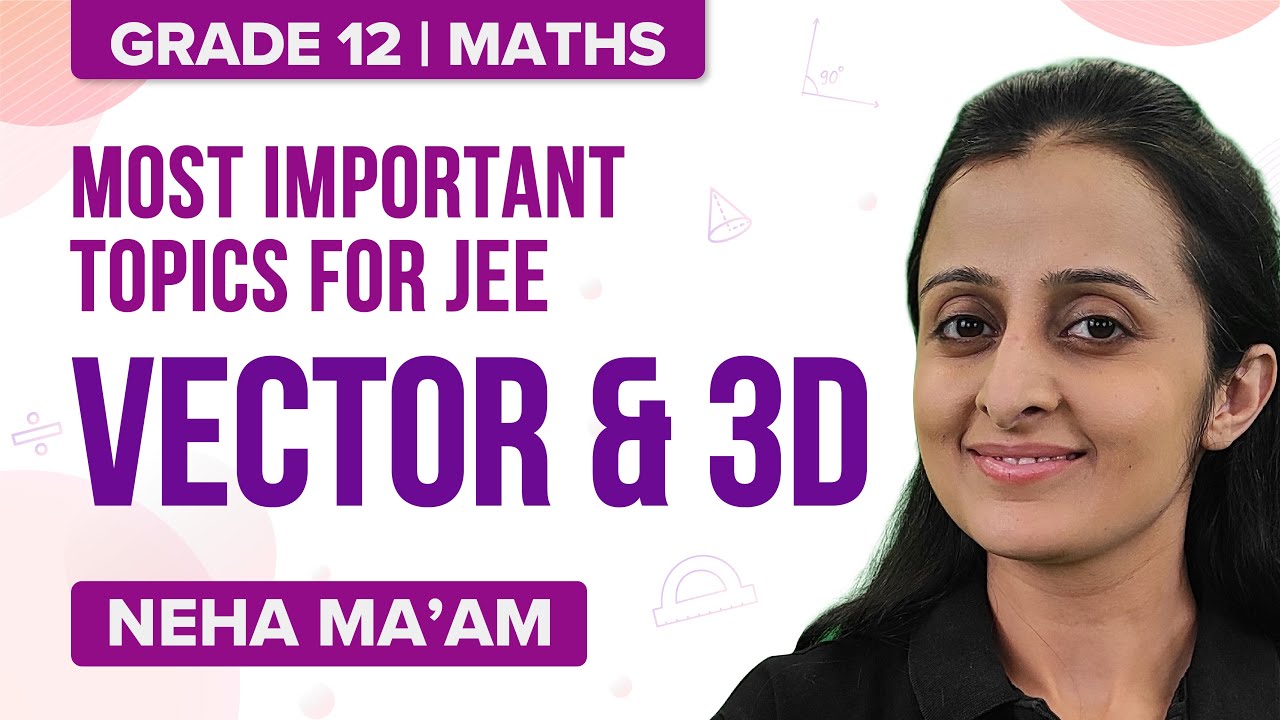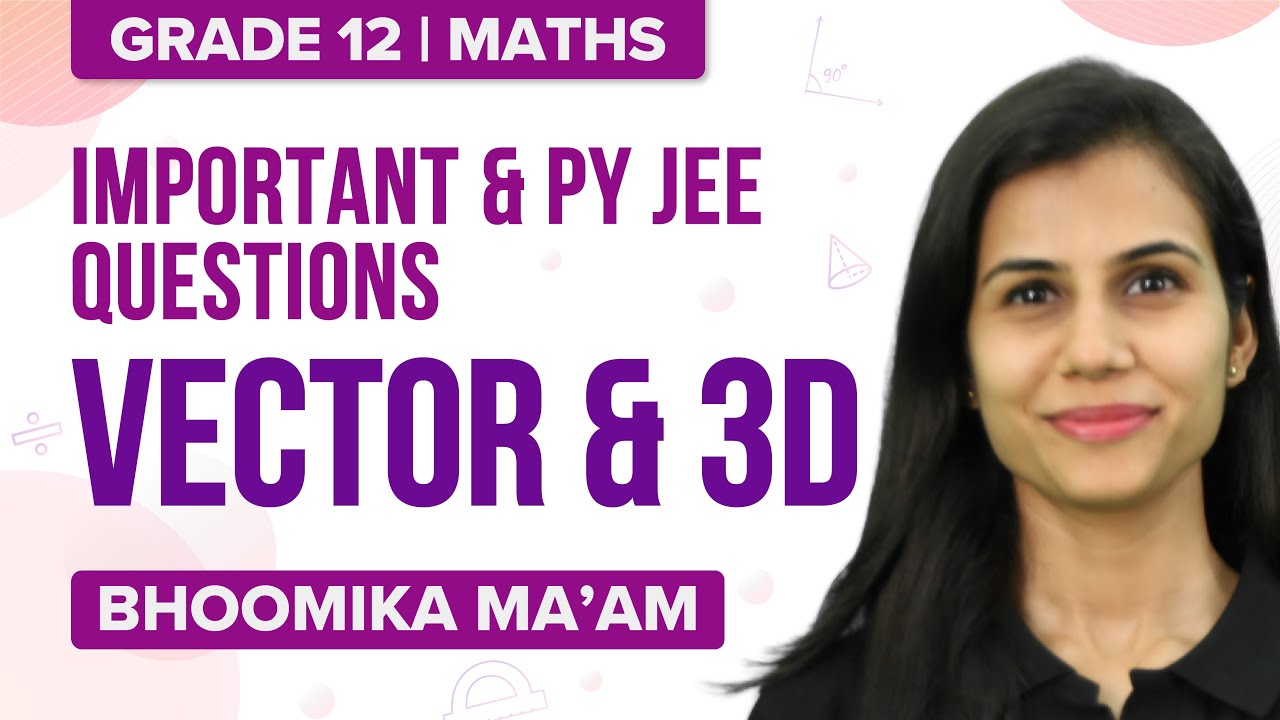In Cartesian geometry, we basically deal with 2-D geometry and 3-D geometry. In two dimensional geometry, we deal with location of a point in x-y plane whereas in three dimensional geometry, we deal with three orthogonal axes,say, x,y and z axes. In short, 3-D Geometry is nothing but an extension of 2-D geometry in Cartesian geometry. In this article we more concentrate on three dimensional geometry basics and important problems for JEE aspirants. The 3-D geometry is also called Solid Geometry, since it deals with 3-D mathematics of 3d shapes like cubes, cuboids, tetrahedrons, parallelepiped etc. Three-Dimensional Geometry or solid geometry is one of the most interesting and important topics for JEE. This article covers direction cosine, direction ratio, vector equation of a line, cartesian equation of a line, the distance between parallel lines, equation of a plane, etc. Three-Dimensional Geometry questions from the previous years of JEE Main are present in this page, along with the detailed solution for each question. These questions include all the important topics and formulae.
Three Dimensional Geometry Previous Year Questions With Solutions
Question 1: The projection of any line on co-ordinate axes be, respectively 3, 4, 5 then its length is ______.
Solution:
Let the line segment be AB, then as given AB cos α = 3, AB cos β = 4, AB cos γ = 5
⇒ AB2 (cos2α + cos2β + cos2γ) = 32 + 42 + 52
AB = √[9 + 16 + 25] = 5√2,
where α, β and γ are the angles made by the line with the axes.
Question 2: The angle between two diagonals of a cube will be _____.
Solution:

Let the cube be of side ‘a’ and O (0, 0, 0), D (a, a, a), B (0, a, 0), G (a, 0, a).
Then the equation of OD and BG are x/a = y/a = z/a and x/a = [y − a]/[−a] = z/a, respectively.
Hence, the angle between OD and BG is
Question 3: The co-ordinates of the foot of perpendicular drawn from point P (1, 0, 3) to the line joining the points A (4, 7, 1) and B (3, 5, 3) is _______.
Solution:

Let D be the foot of perpendicular drawn from P (1, 0, 3) on the line AB joining (4, 7, 1) and (3, 5, 3).
If D divides AB in ratio λ : 1, then
Direction ratios of PD are 2λ + 3, 5λ + 7, −2.
Direction ratios of AB are −1, −2, 2 [Because PD⊥AB]
− (2λ + 3) −2 (5λ + 7) − 4 = 0
λ = −7 / 4
Putting the value of λ in (i), we get the point D (5/3, 7/3, 17/3).
Question 4: A line with direction cosines proportional to 2, 1, 2 meets each of the lines x = y + a = z and x + a = 2y = 2z. The coordinates of each of the points of intersection are given by __________.
Solution:
Let the two lines be AB and CD having equations
x / 1 = [y + a] / 1 = z / 1 = λ and [x + a] / [2] = y / 1 = z / 1 = μ then
P = (λ, λ − a, λ) and Q = (2μ − a, μ, μ)
So, according to question, [λ − 2μ + a] / [2] = [λ − a − μ] / [1] = [λ − μ] / [2]
μ = a and λ = 3a
Therefore, P = (3a, 2a, 3a) and (a, a, a).
Question 5: The distance of the point (1, -2, 3) from the plane x − y + z = 5 measured parallel to the line x / 2 = y / 3 = z / −6, is __________.
Solution:
Direction cosines of line = (2 / 7, 3 / 7, −6 / 7)
Now, x′ = 1 + [2r /7], y′ = −2+ [3r / 7] and z′ = 3 − [6r / 7]
Therefore, (1 + [2r / 7]) − (−2 + [3r / 7]) + (3 − [6r / 7])
= 5
⇒ r = 1
Question 6: A point moves so that the sum of its distances from the points (4, 0, 0) and (-4, 0, 0) remains 10. The locus of the point is _______.
Solution:
√[(x − 4)2 + y2 + z2 ]+ √[(x + 4)2 + y2 + z2 ] = 10
⇒ (x2 + y2 + z2 − 34)2 = [(x − 4)2 + y2 + z2] [(x + 4)2 + y2 + z2]
⇒ (x2 + y2 + z2)2 − 68 (x2 + y2 + z2) + (34)2 = [(x2 + y2 + z2 + 16) − 8x] [(x2 + y2 + z2 + 16) + 8x]
= (x2 + y2 + z2 + 16)2 − 64x2
Solving both sides, we get;
⇒ 9x2 + 25y2 + 25z2 − 225 = 0
Question 7: The centre of the sphere passes through four points (0, 0, 0), (0, 2, 0), (1, 0, 0) and (0, 0, 4) is ________.
Solution:
Let the equation of sphere be x2 + y2 + z2 + 2ux + 2vy + 2wz + d = 0
Because it passes through origin (0, 0, 0), d = 0 and also, it passes through (0, 2, 0)
4 + 4v = 0 ⇒ v = −1
Also, it passes through (1, 0, 0)
1 + 2u = 0 ⇒ u = − 1/2
And it passes through (0, 0, 4)
16 + 8w ⇒ w = −2
Centre (−u, −v, −w)=(1 / 2, 1, 2)
Question 8: Co-ordinate of a point equidistant from the points (0,0,0), (a, 0, 0), (0, b, 0), (0, 0, c) is ___________.
Solution:
The required point is the centre of the sphere through the given points.
Let the equation of sphere be x2 + y2 + z2 + 2ux + 2vy + 2wz + d = 0 …..(i)
Sphere (i) is passing through (0, 0, 0), (a, 0, 0), (0, b, 0) and (0, 0, c), hence, d = 0
a2 + 2ua = 0 ⇒ u = −a/2
b2 + 2vb = 0 ⇒ v = −b/2
c2 + 2wc = 0 ⇒ w = −c/2
Therefore, centre of sphere is (a/2, b/2, c/2), which is also the required point.
Question 9: If the plane 2ax − 3ay + 4az + 6 = 0 passes through the midpoint of the line joining the centres of the spheres x2 + y2 + z2 + 6x − 8y − 2z = 13 and x2 + y2 + z2 − 10x + 4y − 2z = 8, then a equals ____________.
Solution:
S1 = x2 + y2 + z2 + 6x − 8y − 2z = 13, C1 = (−3, 4, 1)
S2 = x2 + y2 + z2 − 10x + 4y − 2z = 8, C2 = (5, −2, 1)
So, mid point of C1 C2 (say P)
Now the plane 2ax − 3ay + 4az + 6 = 0 passes through the point P,
So, 2a (1) − 3a (1) + 4a (1) + 6 = 0
=> 2a −3a + 4a + 6 = 0
3a + 6 = 0
3a = −6
⇒a = −2
Question 10: The radius of circle whose centre touches the line x + 2y + 2z = 15 and x2 + y2 + z2 − 2y − 4z = 11 is ___________.
Solution:
Equation of sphere is, x2 + y2 + z2 − 2y − 4z = 11
Centre of sphere = (0, 1, 2) and radius of sphere = 4
Let the centre of the circle be (α, β, γ).
The direction ratios of a line joining from the centre of the sphere to the centre of the circle are
(α − 0, β − 1, γ − 2) or (α, β − 1, γ − 2)
But, this line is normal at plane x + 2y + 2z = 15
α / 1 = [β − 1]/2 = [γ − 2]/2 = k
α = k, β = 2k + 1, γ = 2k + 2 [Because, centre of circle lies on x + 2y + 2z = 15]
k + 2 (2k + 1) + 2 (2k + 2) = 15
⇒ k = 1
So, the centre of circle = (1, 3, 4)
Therefore, Radius of circle = √[(Radius of sphere)2 − (Length of the line joining centre of the circle and sphere)2]
= √7
Question 11: The point at which the line joining the points (2, -3, 1) and (3, -4, -5) intersects the plane 2x + y + z = 7 is _________.
Solution:
Equation of line passing through (2, -3, 1) and (3, -4, -5) is
(x – x1)/(x2 – x1) = (y – y1)/(y2 – y1) = (z – z1)/(z2 – z1)
=> (x – 3)/-1 = (y + 4)/1 = (z + 5)/6 = k
=> x = 3 – k, y = k – 4, z = 6k – 5
Point intersects the plane 2x + y + z = 7.
=> 2(3 – k) + k – 4 + 6k – 5 = 7
=> 6 – 2k + 7k – 9 = 7
=> 5k = 10
=> k = 2
So the required point is (1, -2, 7).
Question 12: The point where the line
Solution:
Let point be (a, b, c), then 2a + 4b − c = 1 …..(i) and a = 2k + 1,b = −3k + 2 and c = 4k − 3,
(where k is constant)
Substituting these values in (i), we get
2 (2k + 1) + 4 (−3k + 2) − (4k − 3) = 1
⇒ k = 1
Hence, the required point is (3, -1, 1).
Trick: The point must satisfy the lines and plane.
Question 13: The equation of the straight line passing through the point (a, b, c) and parallel to the z-axis, is ________.
Solution:
The direction cosines of line parallel to z-axis are (0,0,1).
Since, the line passes through (a, b, c).
Hence, the line will be
Question 14: The acute angle between the line joining the points (2, 1, -3), (-3, 1, 7) and a line parallel to
Solution:
Direction ratio of the line joining the point (2, 1, −3), (−3, 1, 7) are (a1, b1, c1) ⇒ (−3 −2, 1 − 1, 7 − (−3))
⇒ (−5, 0, 10)
Direction ratio of the line parallel to line
⇒ (3, 4, 5)
Angle between two lines,
Question 15: If l1, m1, n1 and l2, m2, n2 are the direction cosines of two perpendicular lines, then the direction cosine of the line, which is perpendicular to both the lines, will be ______.
Solution:
Let lines are l1x + m1y + n1z + d = 0 ..(i) and
l2x + m2y + n2z + d = 0 …..(ii)
If lx +my + nz + d = 0 is perpendicular to (i) and (ii), then, ll1 + mm1 + nn1 = 0, ll2 + mm2 + nn2 = 0
Therefore, direction cosines are (m1n2 − m2n1), (n1l2 − l2n1), (l1m2 − l2m1).
Also Read
JEE Advanced Maths Three Dimensional Geometry Previous Year Questions with Solutions
Video Lessons
Vector Algebra and 3D Geometry

Important Questions Vector and 3D


Comments